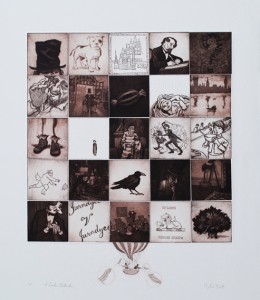Intaglio Printing (Etching)
Intaglio is the form of printing and printmaking techniques in which the image is incised into a surface, and the incised line or sunken area holds the ink. It is the direct opposite of a relief print.
Normally, copper or zinc plates are used as a surface or matrix, and the incisions are created by etching, engraving, drypoint, aquatint or mezzotint. Acid is also used to create these grooves that are then filled with ink. The image is created when the ink is retrieved from the recessed areas of the plate.
Etching is a technique through which prints are made by inscribing an image on to a metal plate(copper, zinc or steel most commonly used) that is then bitten with acid. The plate is first coated with an acid resistant waxy substance (called ground) and a sharp tool or etching needle is used to create the image. The plate is then dipped in a bath of acid.The acid bites into the metal where it is exposed, leaving behind lines sunk into the plate. The longer the plate is immersed in the acid, the coarser the exposed lines will be. The plate is then inked all over and then the ink wiped off the surface, leaving behind only the ink in the etched lines. The plate is then put through a high-pressure printing press with a sheet of paper and the paper then picks up the ink from the etched lines, making a print.
Copper is a traditional metal used, and is still preferred among many printers for etching, as it bites evenly, holds texture well, and does not distort the colour of the ink when wiped. The type of metal used for the plate impacts the number of prints the plate will produce. The firm pressure of the printing press slowly rubs out the finer details of the image with every pass through.

